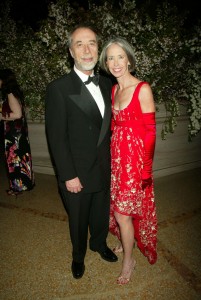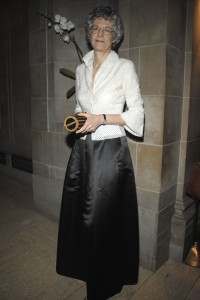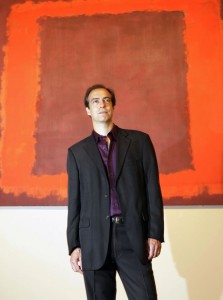
“What do you see?
That is the opening line in RED, the 2009 play about Mark Rothko written by John Logan. Alfred Molina, playing Rothko memorably on Broadway, opens the 90-minute piece, pointing to one of the painter’s infamous red and black works – or since we are on stage, a replica – and asks: “What do you see?”
That’s my question as I sit off and on in the packed courtroom on the third floor of the Thurgood Marshall Courthouse at 40 Center Street in New York, where Judge Paul Gardephe is hearing the month-long civil case of luxury goods magnate (and Sotheby’s chairman) Domenico de Sole, and his wife Eleanore (above) , against Ann Freedman, the former president of the Knoedler Gallery, the oldest art gallery in New York until it abruptly closed in 2011. The de Soles argue that Freedman and Knoedler knowingly sold them a fake Rothko, Untitled 1956, for $8.3 million in 2004. (A Long Island woman, Glafira Rosales, has already pled guilty to peddling Knoedler forty or so fake works created by Queens street artist Pei-Shen Quian, which the gallery then resold at staggering markups.) Meanwhile, a criminal investigation hovers. Rosales has not yet been sentenced, and her co-conspirators, Qian and her boyfriend, Jose Carlos Bergantinos Diaz, as well as Diaz’ brother, await extradition from China and Spain, respectively. At stake, many in the art world believe, is the opaque manner in which dealers and galleries operate, hiding behind the mythology of expensive art created by talented drug addicts and drunkards, many of whom left imperfect records. Dealers are not required to tell customers the identity of sellers, a standard that would never fly in, say, high-end real estate, or any other multimillion-dollar field.
What do you see?
Apparently RED is on the mind of several people in court. As she was leaving court last Wednesday, Eleanor de Sole told journalists she’d seen the play performed in her hometown of Hilton Head, South Carolina. So what is it we currently see in the courtroom?
First we see theater: a real-time, real-life high-stakes drama that transports one into the multi-layered art world, a jigsaw-puzzle of innumerable experts, historians, researchers, conservators, and middlemen all looking for an angle and a cut. (Never again will I listen to any art professional who says, “I’m only interested in art, not the commercial side of the industry.”) Simply put, there is no art without money: the relationship is symbiotic. Christopher Rothko, Mark’s son, has been in court testifying that he has a policy of never authenticating his father’s work. David Anfam, the world’s leading expert on Rothko and author of the Catalogue Raisonne, has said the same thing. Why? Not because they can’t recognize Rothko’s art (Anfam was clear on that) but because too much money is at stake. Rothko told Ann Freedman back in the day he thought the fake Rothko was “beautiful,” but he was not prepared to document that it was also real. The reliance the whole industry places on nebulous-sounding oratory rather than solid documentation is almost comic. No other sophisticated business does transactions based on verbal fairy-tales. The defense, according to Freedman’s lawyer Luke Nikas, plans to show early next week that this “context” – the very real world of fairy tales and no documentation – is crucial to understanding it all.
So far the testimony has taken us back to the 1990s and 2000s, inside the opulent walls of the high-windowed Knoedler Gallery on 70th and Madison. Founded in 1846, Knoedler was the oldest, most reputable gallery in America. Ann Freedman, 68, sitting tall off to the left as you face Judge Gardephe, is a reedy, grey-haired, bespectacled woman who looks more like a university don than a hard-charging saleswoman; however, it was Freedman who battled her way up from Knoedler’s receptionist to become its president in 1994, earning herself a reputation that commanded respect, yes, but also fear. Peers thought she was sharp-elbowed. Many complained of the abrupt way she replaced her well-liked predecessor Larry Rubin, reportedly changing the succession arrangement he’d set up.
We also learned last week that certain people in the art community didn’t like her way of conducting business. In 1994, which was when Rosales first brought her fake wares to Knoedler, the British-born MoMA curator John Elderfield told Freedman that he didn’t think two Richard Diebenkorn works the gallery was showing were authentic. Phyllis Diebenkorn, the artist’s widow, who was with him, agreed, according to Elderfield; so too did the Diebenkorns’ daughter Gretchen, who testified that the paintings “lack soul.” Elderfield tried to be British and polite about his misgivings, which in hindsight might have been a mistake. Assuming Freedman would withdraw the works, he’d be “dismayed” ten years later to discover she had sold them. Diebenkorn’s wife was outraged. But – and it’s a big but – she never wrote to Freedman or anyone complaining.
Meanwhile, as many have testified, Ann Freedman was extremely successful at finding and selling first-rate contemporary art. Her “brand,” to quote Domenico de Sole (who, one could argue, knows a thing or two about brands given his stewardship of Gucci and now Tom Ford) was impeccable. De Sole told jurors that under her rule, the Knoedler Gallery continued to be thought of in superlatives. It was “the top.”
This was the reason, de Sole told the jury, that he and his wife, Eleanor, a former IBM executive, showed up for an appointment at Knoedler in late 2004. They’d never met Freedman, but they knew her “brand.” They also knew she represented an Irish artist, Sean Scully, whose work they’d recently admired on a friend’s wall. At that point the de Soles collected art but had never spent more than $2 million on a single item. They are rich, yes, but not billionaires. De Sole, a Harvard-trained-lawyer, had “worked hard” to get where he is, he explained.
As it turned out, Freedman told the de Soles in 2004 she did not have a Sean Scully, according to de Sole, so he asked to see the two works she did have in the office, prompting her to unwrap a Jackson Pollock she said was available for over $11 million. There was also the red and black Rothko,Untitled 1956, available for $8.5 million.
While de Sole described the scene, its subject, the painting, was beside him on an easel. It was displayed casually, almost absurdly so given the dramatic “unveiling” being discussed. “Aggressive” was the word de Sole used to describe Freedman’s pitch. She mentioned a Swiss “client” who wanted to sell his paintings discreetly. His father had been the collector. (Earlier that morning in the courtroom, one of Knoedler’s researchers, Melissa De Medeiros, had been forced to admit that although the gallery came up with various “plausible” storylines about who might have advised this client’s father, known as “Mr. X”, Knoedler had no concrete idea who this person was.)
But to the de Soles Ann Freedman gave the impression she not only knew the “client” but that all sorts of experts, including Christopher Rothko and David Anfam, had seen the work and validated it. (Anfam and Rothko both denied this.) “Magnificent” was another word Freedman used. De Sole would ask her to put it all in writing, which she did. Her letter, shown to the jury, clearly says that Knoedler warranted the authenticity of Untitled, 1956.
De Sole and his wife let the painting, once purchased, go abroad to be viewed at the prestigious Beyeler Foundation in Switzerland, then hung it in their house in South Carolina, where many friends came to view it, said de Sole. It was bought for his daughter Laura, since he and Eleanor have taken trouble to divide up their estate fairly between Laura and another daughter, who “fight,” according to their mother.
But one morning in 2011, after he got out of the shower, de Sole found his wife shaking. She’d read a story in the New York Times saying that another painting, Untitled 1950 by Jackson Pollock, sold to hedge fund manger Pierre LaGrange by Knoedler in 2007 for $17 million, was fake. The provenance – a Swiss collector had supposedly owned it – sounded all too familiar. De Sole would ultimately call Freedman, who stated that Lagrange was wrong. Both his painting and De Sole’s were the real deal. The word “aggressive” was used again.
That was the last time Freedman and de Sole spoke. A criminal investigation began; the Knoedler gallery closed. The truth about Rosales and her scheme would emerge. Freedman, who has not yet testified, will argue that she too was a victim, having bought three works from Rosales too. (At far less of a markup than her customers.) A startled de Sole testified that he had only discovered in court that the “Rothko” he bought from Ann Freedman for $8.3 million had been purchased from Rosales by Freedman for a mere $950,000. He was spluttering as he got that last part out.
How did you feel about the painting once you discovered it was a fake? he was asked. “It was worthless,” he said, adding his wife now cries at night, and finally, “I got a fake painting for $8.3 million and they don’t want to give it back to me.”
And all the while the painting sat there beside him. At some point the lawyers picked it up and took it out – fast. Had it been worth $8.3 million – or more, because a real Rothko by would have appreciated significantly – men in white gloves would have been called. It was now a rough-handled object of scorn.
And there, really, is the puzzle at the heart of all this for people who don’t spend their time pouring over art catalogues or traipsing through galleries. How is it that one moment a painting can be loved and admired, hung on a museum’s walls, and the next it is “worthless,” jostled, bounced about, and cried over? Surely the painting was still the painting.
What do you see?
However this ends, the spectacle of that painting in court is a deconstructive mockery of all the murky pretension, hypocrisy, and greed around it. It’s testament if ever there was that art – and, as a lover of Keats and a believer in truth being beauty and all that suggests, I really hate to say this – has no intrinsic value. The value consists entirely in the perception of where it came from, not what it is.
What do you see?
So what I see in court during this trial is a rapidly expanding global industry that, terrifyingly, has zero regulation, is rife with corruption, price-fixing and self-interest, and is little more than a shady, self-interested cartel based on . . . nothing.
And that’s a depressing spectacle.

